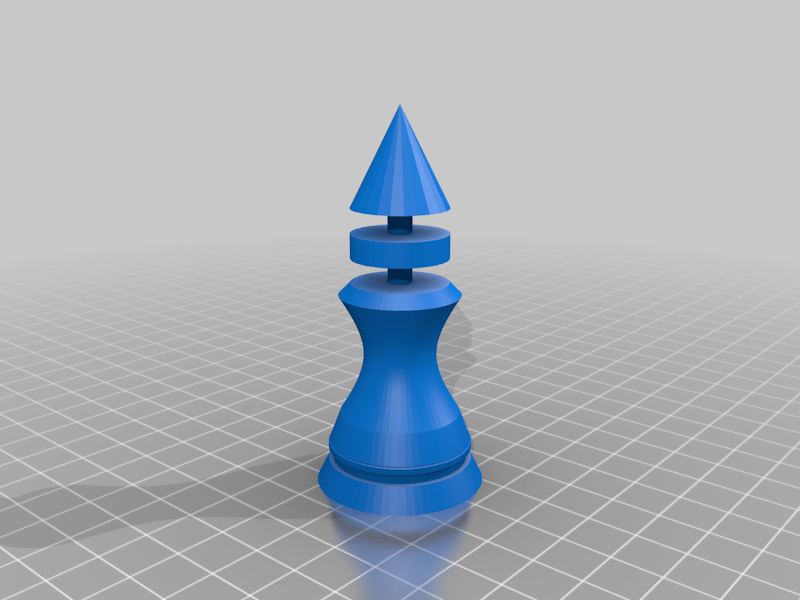Ratings & Comments
283. General. There have been many pieces called simply "General" over the years, not even considering those in Shogi and elsewhere that have adjectives and other modifiers in their names. This version, the one that I prefer to use, was created by Guiseppi Ciccolini in 1820 for his version of chess. It slides diagonally like a Bishop, or orthogonally an even number of spaces like a lame Dabbabarider. (BnDD)

István Paulovits also created his own General in 1820, which moves as Mann or Camel (KC); I'll address that one at a later date.

The model is based on a bit of 2D art that someone did for what a Gold or Silver General from Shogi would look like as a chess piece. Looking at it now, I think the center strut probably should be thickened (both for sturdiness and to better match the illustration).
Sorry, I was wrong. The real explanation is that they only jump to capture. It works correctly anyhow.
I have feared them being game breaking. Otherwise said, it feels like having a random effect.
Ok, I thought it is like in tenjiku shogi!
Since this comment is for a page that has not been published yet, you must be signed in to read it.
Since this comment is for a page that has not been published yet, you must be signed in to read it.
I've never had a problem with them and it's still unclear to me what that would look like.
They work the same as in the interactive diagram, only jumping over enemies.
 A. M. DeWitt wrote on Fri, Apr 26 10:40 AM UTC in reply to François Houdebert from 08:19 AM:
A. M. DeWitt wrote on Fri, Apr 26 10:40 AM UTC in reply to François Houdebert from 08:19 AM:That's perfect.
@Aurelian: I found the Joker difficult to play on-line because you need to have in mind what was the last piece moved and that the Joker mimics. If you play several games in parallel and that a succesive move may happen in the next days, it is difficult. Maybe this is why this interesting piece lacks of popularity. It is probably different when played over a board and in a short time frame.
better like this ?
It seems people are not that interested in this topic. I'm thinking that this is because there is not a lot of experience in games with jokers.
Anyway after a intensive series of games played against the ID these days, I have concluded that on a 10x10 board at least things are ok. What bad thing that can happed is to lose connected pawns, because then the joker is not easily trapped by just moving a pawn. So one has to protect connected pawns, especially near the king, even from sacrifices. That is actually a strategic choice on part of the attacker. I think this is actually a good thing.
So my own verdict is that on a 10x10 board the joker works.
Flying pieces still do not fly!
Since this comment is for a page that has not been published yet, you must be signed in to read it.
 A. M. DeWitt wrote on Fri, Apr 26 12:48 AM UTC:
A. M. DeWitt wrote on Fri, Apr 26 12:48 AM UTC:I noticed a bug in the Hectochess implementation. When castling, the starting squares of the Champions and queenside Knights (b2/b9, c2/c9, and i2/i9) are not being checked to see if a piece is occupying them or not, allowing castling when it should not be possible to do so.
 A. M. DeWitt wrote on Thu, Apr 25 11:47 PM UTC in reply to Bob Greenwade from Mon Apr 1 04:42 PM:
A. M. DeWitt wrote on Thu, Apr 25 11:47 PM UTC in reply to Bob Greenwade from Mon Apr 1 04:42 PM:I notice that Lev nominated Seireigi, so in addition to my nomination of its larger cousin (Dai Seireigi) I'll throw in a second for Seireigi for future features.
You must really like Dai Seireigi...I'm honestly quite surprised. Sure, I consider the Seireigi family my best set of works so far, but I didn't think anyone would be so quick to nominate Dai Seireigi. If anything, I thought Chu Seireigi would be nominated faster (second to normal Seireigi of course). That being said, I can definitely see the appeal, with the homages to the large historical Shogi variants and all.
Note to (other) Editors: While Dai Seireigi hasn't been played in its current, final form on Game Courier yet, it does have a recorded history of development versions being played on Game Courier. Whether this would make it eligible to be featured is up for debate.
 A. M. DeWitt wrote on Thu, Apr 25 11:34 PM UTC:
A. M. DeWitt wrote on Thu, Apr 25 11:34 PM UTC:I second Glinski's Hexagonal Chess. It is the textbook example of a hexagonal chess variant. If you want to learn how to play a hexagonal chess game, Glinski's Hexagonal Chess is a great place to start.
 💡📝A. M. DeWitt wrote on Thu, Apr 25 08:53 PM UTC in reply to François Houdebert from 07:48 PM:
💡📝A. M. DeWitt wrote on Thu, Apr 25 08:53 PM UTC in reply to François Houdebert from 07:48 PM:Looks like it. I have uploaded the new version to the site and have adapted them so the implementation will work properly with the CVP files.
Since this comment is for a page that has not been published yet, you must be signed in to read it.
25 comments displayed
Permalink to the exact comments currently displayed.

Big thanks for publishing Û,Û